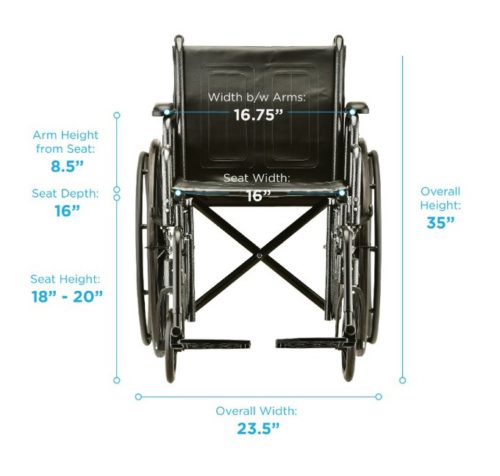Wheelchair Widths & Weights Explained (Easy Guide)

Table of Contents
Wheelchair Widths & Weights Explained (Easy Guide)
Unsure about wheelchair dimensions or weight?
This guide answers “how wide is a standard wheelchair” and “weight of wheelchairs,” so you can make informed choices!
Finding the Perfect Fit: Unveiling Standard Wheelchair Widths
Imagine yourself zipping down the hallway at school in your excellent wheelchair. Suddenly, you approach a narrow doorway. Will your chair fit through? Knowing a wheelchair’s width is crucial for navigating everyday adventures.
There isn’t a single, one-size-fits-all width for wheelchairs. They come in various sizes to accommodate different people’s needs. However, there is a standard width that serves as a good starting point.
The Standard Wheelchair Width Revealed
A standard manual wheelchair typically measures between 24 and 26 inches wide. This measurement refers to the broadest part of the chair, usually at the wheels. This standard size allows for comfortable maneuvering in most indoor spaces, doorways, and hallways.
It’s important to remember that this is just a general guideline. Wheelchair width can vary depending on several factors, including:
- User’s size and needs: Larger individuals may require a wider chair for better support and comfort.
- Type of wheelchair: Some specialty wheelchairs, like sports wheelchairs, might be narrower for increased agility.
- Armrests: Detachable or removable armrests can slightly adjust the overall width.

Image of standard wheelchair width measurement
Exploring Different Wheelchair Width Options
While the standard size is widely used, there’s a whole world of wheelchair options available. Let’s explore some variations:
- Lightweight or ultralightweight wheelchairs: These champions of portability often have a narrower width (around 16 to 20 inches) for easier lifting and storage.
- Heavy-duty wheelchairs: Designed for users who require extra support, these chairs can be more comprehensive (up to 30 inches or more) to accommodate increased weight capacity.
- Power wheelchairs: The base width of a power wheelchair can be similar to a standard manual chair, but consider the additional width of joystick controls or armrests.
Weighing In: Understanding Wheelchair Weights
The weight of a wheelchair is another crucial factor to consider. After all, you might need to lift it into a car or maneuver it over different terrains.
Here’s a breakdown of wheelchair weights to give you a general idea:
- Manual wheelchairs: These typically range from around 15 pounds for lightweight models to over 50 pounds for heavy-duty options.
- Power wheelchairs: Due to the motor and battery, power wheelchairs tend to be heavier than manual wheelchairs. Their weight can vary significantly, ranging from around 33 pounds for lightweight models to well over 200 pounds for heavy-duty models.

Image of a person lifting a manual wheelchair
Weight Considerations for Different Needs
Just like width, wheelchair weight can vary depending on several factors, including:
- Type of wheelchair: As mentioned earlier, power wheelchairs are generally heavier than manual wheelchairs.
- Features: Additional features like reclining seats, leg rests, or headrests can add weight to the chair.
- Material: Steel frames are sturdier but heavier, while aluminum frames are lighter but might not be suitable for everyone.
Making the Right Choice: Matching Width and Weight to Your Needs
Choosing the correct wheelchair width and weight is an important decision. Here are some tips to help you navigate the options:
- Consider your needs: Think about your daily activities, where you’ll be using the wheelchair, and any physical limitations you might have.
- Get measured: A healthcare professional can help you determine the ideal width for your comfort and safety.
- Try before you buy: Whenever possible, test drive different wheelchairs to see which one feels most comfortable and manageable for you.
Remember: Consulting a healthcare professional or occupational therapist is essential to finding the perfect wheelchair combination of width and weight for your specific needs.
Frequently Asked Questions (FAQs)
Q: How can I measure the width of a doorway to see if my wheelchair will fit?
A: Use a standard measuring tape to measure the precise width of the doorway. Remember to account for any space occupied by doorknobs or hinges.
Q: What if my standard wheelchair doesn’t fit through a doorway?
A: Doorway widening kits are available that can temporarily increase the doorway width. However, permanent modifications might require consulting a professional.
Q: Can I modify the width of my wheelchair?
A: In most cases, modifying the width of a wheelchair frame is not recommended. It can compromise the chair’s structural integrity and safety. Always prioritize using a wheelchair that fits you properly.
Q: I’m interested in a lightweight wheelchair, but will it be strong enough for me?
A: Lightweight wheelchairs are designed for portability and maneuverability. While they might have a lower weight capacity than standard or heavy-duty chairs, they come in various weight capacities. A healthcare professional can help you choose a lightweight wheelchair that offers the right balance of weight and support for your needs.



